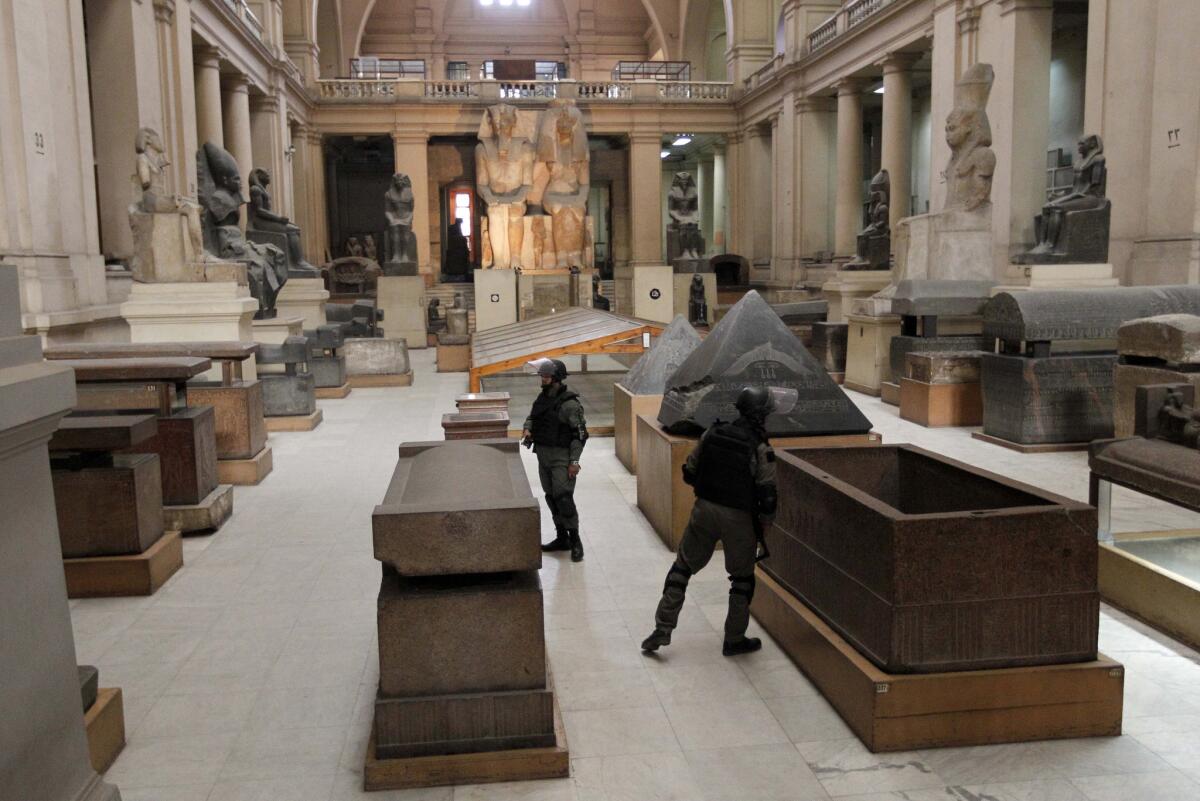Zahi Hawass is on the stump again for ancient Egypt’s Pharaohs

For many years, Zahi Hawass has been the living face of ancient Egypt, an ambassador for long-dead Pharaohs who uses his high-wattage personality, telegenic showmanship and knack for wading confidently into controversy to preserve both their star power and the monuments that hordes of laborers built at their command.
The Pharaohs — and his homeland — may need him more than ever now, even though he was unseated from his post as Egypt’s chief of antiquities during the tumult and political upheaval that started with the January 2011 protests in Tahrir Square and turned into a revolution.
It could have been much worse for Hawass, 67, whose career had thrived under Hosni Mubarak’s authoritarian regime. After Mubarak fell, Hawass, whose imperious side earned him his share of enemies, found himself not just fired from his job as minister of state antiquities but also the target of corruption allegations. He says he had to stay in Egypt for a year while the investigation proceeded.
But the fast-moving, history-making cycle of events in Egypt took another turn last year, and Hawass is back in the United States, recently absolved of all charges and on the stump for the Pharaohs once more. He recently spoke at the Bowers Museum in Santa Ana.
Tourists’ spending looms large in the Egyptian economy — and it’s especially important for funding its museums, protecting its ancient sites and pushing ahead with archaeological excavations aimed at unearthing more understanding of the ancient past and more wonders to attract travelers.
“With all this, I have to tell you that Egypt is safe,” Hawass said before his Bowers talk — “this” meaning three years of volcanic contemporary history.
Turmoil’s effects
His lecture at the Bowers didn’t try to hide some of the ill effects of the turmoil on Egyptian antiquity. After an introductory film that included video bites from some of the critics who think he’s more a showman than a serious archaeologist, countered by highly placed fans who think he’s a passionate and effective popularizer of the ancient world — Hawass began his slide-aided talk by showing how the Egyptian Museum in Tahrir Square had been broken into in the early hours of the revolution.
Pictures showed shattered display cases, a broken statuette and mummies flung from their coffins. But the photos also showed some of the protesters forming a human chain to protect the museum from further theft or damage, and Hawass said losses were minimal.
As Mubarak fell (he recently was sentenced to three years in prison for corruption), his successor, Mohammed Morsi, ascended and then was deposed in a military coup, along with his religious party, the Muslim Brotherhood. With Morsi facing murder charges, his successor, former military commander Abdel Fattah Sisi, was elected Egypt’s president in a late-May landslide.
Hawass said that the newly elected government marks a turning point.
“We need a strong leader, and Sisi is the perfect person,” he said, sporting a black pinstriped suit and perfectly coiffed white hair with a rippling wave in it. As if his emphatic and hyper-animated voice weren’t enough, Hawass leaned forward repeatedly, prodding a listener on the shoulder or chest to drive home his points while making the exchange seem personal and intimate.
Zahi, as he commonly is called, would not be Zahi if he didn’t relate most things back to the Pharaohs.
The 21st century has a clear precedent in the 22nd, he said — BC, that is. He related how a “harem conspiracy” initiated by concubines led to the death of Pharaoh Pepi II some 4,200 years ago, ending a reign said to have lasted 90 years, or about triple Mubarak’s tenure. Pepi’s end ushered in upheaval and disunity for 140 years, Hawass said, until Mentuhotep II, a military man like Sisi, reunified Egypt and began a new dynasty that lasted 300 years.
“The big difference is that Sisi was elected,” Hawass said.
At first, the political earthquake of early 2011 brought Hawass a promotion. Trying to hold onto power in the face of protesters demanding he step down, Mubarak restructured his government and Hawass was elevated from the equivalent of a department head, secretary general of the Supreme Council of Antiquities, to the new cabinet-level position of minister of state antiquities.
He was, after all, perhaps the Egyptian face most familiar to the public outside the Middle East, known for television specials that included sending a robot probe into the Great Pyramid at Giza and overseeing a CT scan of King Tut’s mummy. He’s also made headlines demanding the return of prized objects he says were spirited out of Egypt illegally — the Rosetta Stone at the British Museum in London and a famed bust of Queen Nefertiti that resides in a museum gallery in Berlin.
The diagnostic test on Tut’s remains was a prelude to “Tutankhamun and the Golden Age of the Pharaohs,” a touring exhibition that began in 2005 at the Los Angeles County Museum of Art.
For Hawass, it was a scholarly inquiry; for his detractors, mere antics.
Regime change
There was no lack of schadenfreude among them when he got what appeared to be his comeuppance under the Muslim Brotherhood. Hawass told his audience at the Bowers that it was indeed an unpleasant surprise, because he’d expected better things from Egypt’s new regime when it was elected in 2012.
“I voted for Morsi,” he said. “I thought he would be good.”
Instead, Hawass said, Egypt’s antiquities suffered neglect.
“People began building houses at the site of Tell el Amarna, the city of Akhenaten, a very important site,” he said, and many antiquities storage vaults were raided. Hawass said mummies were the intruders’ primary target, because of a folk legend that their throats are filled with a substance called “red mercury” that can heal the sick and ward off demons.
As antiquities chief, Hawass had emphasized turning a selection of Egypt’s prized artifacts into earners by sending them abroad on tour, reaping exhibition fees and merchandising profits, while also trying to entice viewers to visit Egypt for the full experience. Under Morsi, a touring exhibition about Cleopatra that Hawass had sent abroad in 2010 was called back, its artifacts deemed too precious to travel (it did reach L.A., in 2012 at the California Science Center).
Hawass said his main accuser in Egypt was a man who sought revenge after losing the concession to run the museum store at the Egyptian Museum. He said he happily used the downtime while under investigation to catch up on writing field reports about archaeological finds and to work on several new books — the latest is “Discovering Tutankhamun: From Carter to DNA” — Howard Carter being the English archaeologist who discovered Tut’s gold-bestrewn tomb.
Hawass said he’d be willing to serve the Egyptian government again if called upon — perhaps as head of his most prized project, the huge Grand Egyptian Museum under construction near the pyramids at Giza. A 2015 opening was projected when work began before the revolution, but Hawass said it probably wouldn’t be ready until 2020.
He’s pleased with the first actions of the newly installed Sisi government. Its Cabinet includes a new minister of state antiquities, Mamdouh Damaty, who served as director of the Egyptian Museum under Hawass for several years during the 2000s.
“He’s good, he’s clean, he’s a very smart guy,” Hawass said.
But good management may not be enough to save Egypt’s antiquities infrastructure from becoming mummified if tourists don’t return. The Associated Press reported in December that the Egyptian Museum’s revenues had fallen from $16 million for October 2010 to $1.1 million for October 2013. That explains why Hawass is back in international circulation, promoting his book, talking up his land’s ancient wonders and assuring all comers that Egypt is stable and safe once more.
More to Read
The biggest entertainment stories
Get our big stories about Hollywood, film, television, music, arts, culture and more right in your inbox as soon as they publish.
You may occasionally receive promotional content from the Los Angeles Times.











